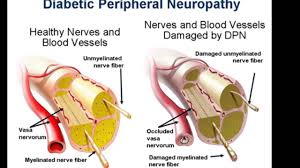- Home
- Editorial
- News
- Practice Guidelines
- Anesthesiology Guidelines
- Cancer Guidelines
- Cardiac Sciences Guidelines
- Critical Care Guidelines
- Dentistry Guidelines
- Dermatology Guidelines
- Diabetes and Endo Guidelines
- Diagnostics Guidelines
- ENT Guidelines
- Featured Practice Guidelines
- Gastroenterology Guidelines
- Geriatrics Guidelines
- Medicine Guidelines
- Nephrology Guidelines
- Neurosciences Guidelines
- Obs and Gynae Guidelines
- Ophthalmology Guidelines
- Orthopaedics Guidelines
- Paediatrics Guidelines
- Psychiatry Guidelines
- Pulmonology Guidelines
- Radiology Guidelines
- Surgery Guidelines
- Urology Guidelines
Special eye examination to detect Peripheral Neuropathy in type 2 DM

About half of those who have had type 2 diabetes for more than ten years have peripheral Neuropathy which usually begins in their feet. Sometimes the reduction in sensation in this condition can cause the need for an amputation. Unfortunately currently the methods available so far at clinics to diagnose the condition are not entirely optimal.Professor Olov Rolandsson at Umea University and colleagues have developed a fast and safe diagnostic method for detecting Peripheral Neuropathy by examining the cornea of the eye with a special microscope. The study has been conducted among diabetics in Skelleftea, north Sweden.
When type 2 diabetes develops, small nerve fibres in the peripheral nervous system begin losing their function even before symptoms become apparent. These small peripheral nerve fibres are found in the skin, but also in the cornea of the eye. Because the cornea is transparent, it is an ideal place to study nerve damage that occurs in diabetics.
"Although there is currently no cure, it's always an advantage to detect changes in the nerves early. Therefore, it's valuable to find a fast and safe diagnostic method," says Professor Olov Rolandsson, at the Department of Public Health and Clinical Medicine, Family Medicine, at Umea University, who was responsible for the study.
In the study with 82 people from Skelleftea, with or without type 2 diabetes, the participants' eyes were examined with a special microscope. The study found that the corneal nerve density was lower in individuals with type 2 diabetes compared to healthy subjects. If the individual had had type 2 diabetes for a longer period of time, nerve density was even more reduced.
The study is the first of its kind in Sweden. Through cooperation between a Swedish research team and researchers in Germany, Italy and Norway, a method has been developed to create images in three dimensions of corneal nerves. The examination only takes ten minutes and does not cause any discomfort to the patients. The research team has also developed an automated analysis programme that allows the method to be used in general health care. Microscopic examination of the cornea occurs internationally, but the Skelleftea study is the first in the world to use the entire new method for assessing the degree of nerve damage in diabetics.
"There are good conditions for this new diagnostic method to be widely introduced in health care," says Olov Rolandsson.
Olov Rolandsson at Umea University in Sweden led the Skelleftea study, while the technical development and microscopy survey was conducted by Docent Neil Lagali at Linkoping University, Sweden. The study is published in the scientific journal IOVS, Investigative Ophthalmology & Visual Science.

Disclaimer: This site is primarily intended for healthcare professionals. Any content/information on this website does not replace the advice of medical and/or health professionals and should not be construed as medical/diagnostic advice/endorsement or prescription. Use of this site is subject to our terms of use, privacy policy, advertisement policy. © 2020 Minerva Medical Treatment Pvt Ltd